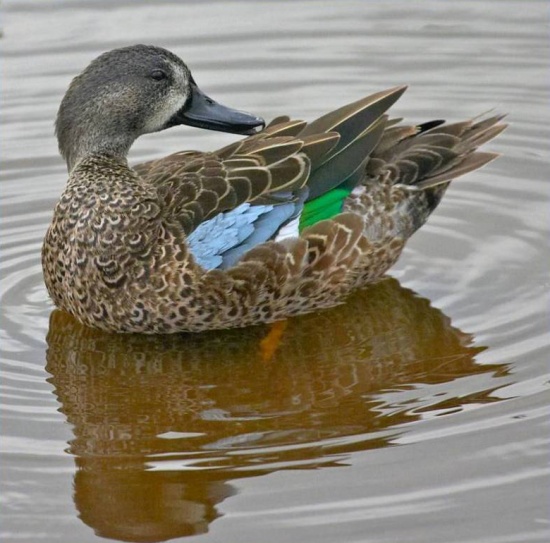JohnN-1520 (talk | contribs) |
m (Links added and tidied up) |
||
| Line 1: | Line 1: | ||
;Anas discors | ;Anas discors | ||
| − | [[Image:Blue-winged_Teal.jpg|thumb|550px|right|Photo by David Roach]] | + | [[Image:Blue-winged_Teal.jpg|thumb|550px|right|Photo by David Roach<br />Photographed at Wakodahatchee]] |
| − | == | + | ==Identification== |
| − | 14-16" (36-41 cm). A small brown duck with pale blue shoulder patches. Male has gray head and white crescent in front of eye. Female mottled brown, similar to female Cinnamon Teal but with obscure patterning on face and to female Green-winged, but grayer and larger billed, with pale blue shoulder patches like the male. | + | 14-16" (36-41 cm). A small brown duck with pale blue shoulder patches. Male has gray head and white crescent in front of eye. Female mottled brown, similar to female [[Cinnamon Teal]] but with obscure patterning on face and to female [[Green-winged Teal|Green-winged]], but grayer and larger billed, with pale blue shoulder patches like the male. |
| − | |||
| + | ==Distribution== | ||
| + | Breeds from southeastern [[Alaska]] and western [[Canada]] to Canadian Maritimes and south to northeastern [[California]], [[New Mexico]], and [[New York]]. Winters from southern [[California]], southern [[Texas]], and [[Carolinas]] southward through tropical [[America]]. | ||
==Habitat : == | ==Habitat : == | ||
Marshes, shallow ponds, and lakes. | Marshes, shallow ponds, and lakes. | ||
| − | |||
| − | ==Nesting | + | ==Nesting== |
9-12 dull white eggs in a down-lined hollow concealed in grass near water. | 9-12 dull white eggs in a down-lined hollow concealed in grass near water. | ||
| − | |||
| − | |||
| − | |||
| − | |||
| − | |||
| − | ==Voice | + | ==Voice== |
Soft lisping or peeping note. Female utters a soft quack. | Soft lisping or peeping note. Female utters a soft quack. | ||
| − | |||
| − | ==Discussion | + | ==Discussion== |
Fast and wary, Blue-winged Teal fly in small groups or flocks, turning in unison and flashing the blue area of the wing. They arrive latest of all ducks at their breeding grounds and leave early in the fall. On low, marshy prairies in the central part of the continent, where this duck is most numerous, virtually every pond and pothole has a breeding pair. The male commonly "stands guard" on the pond while the female is incubating. Unlike other dabbling ducks that form pairs in the fall, this teal begins courting in the spring and often does not acquire the familiar breeding plumage until December or January. Like most ducks, it goes through an eclipse plumage and molts most of its feathers simultaneously, including the primaries, and so is flightless until new feathers grow in. | Fast and wary, Blue-winged Teal fly in small groups or flocks, turning in unison and flashing the blue area of the wing. They arrive latest of all ducks at their breeding grounds and leave early in the fall. On low, marshy prairies in the central part of the continent, where this duck is most numerous, virtually every pond and pothole has a breeding pair. The male commonly "stands guard" on the pond while the female is incubating. Unlike other dabbling ducks that form pairs in the fall, this teal begins courting in the spring and often does not acquire the familiar breeding plumage until December or January. Like most ducks, it goes through an eclipse plumage and molts most of its feathers simultaneously, including the primaries, and so is flightless until new feathers grow in. | ||
| − | + | ||
| − | |||
==External Links== | ==External Links== | ||
{{GSearch|Anas+discors}} | {{GSearch|Anas+discors}} | ||
[[Category:Birds]] | [[Category:Birds]] | ||
Revision as of 11:08, 24 October 2007
- Anas discors
Identification
14-16" (36-41 cm). A small brown duck with pale blue shoulder patches. Male has gray head and white crescent in front of eye. Female mottled brown, similar to female Cinnamon Teal but with obscure patterning on face and to female Green-winged, but grayer and larger billed, with pale blue shoulder patches like the male.
Distribution
Breeds from southeastern Alaska and western Canada to Canadian Maritimes and south to northeastern California, New Mexico, and New York. Winters from southern California, southern Texas, and Carolinas southward through tropical America.
Habitat :
Marshes, shallow ponds, and lakes.
Nesting
9-12 dull white eggs in a down-lined hollow concealed in grass near water.
Voice
Soft lisping or peeping note. Female utters a soft quack.
Discussion
Fast and wary, Blue-winged Teal fly in small groups or flocks, turning in unison and flashing the blue area of the wing. They arrive latest of all ducks at their breeding grounds and leave early in the fall. On low, marshy prairies in the central part of the continent, where this duck is most numerous, virtually every pond and pothole has a breeding pair. The male commonly "stands guard" on the pond while the female is incubating. Unlike other dabbling ducks that form pairs in the fall, this teal begins courting in the spring and often does not acquire the familiar breeding plumage until December or January. Like most ducks, it goes through an eclipse plumage and molts most of its feathers simultaneously, including the primaries, and so is flightless until new feathers grow in.




